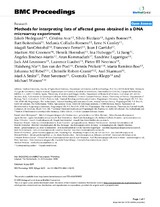Methods for interpreting lists of affected genes obtained in a DNA microarray experiment

Ver/
Autor
Hedegaard, Jakob
Arce Jiménez, Cristina
Bicciato, Silvio
Bonnet, Agnès
Buitenhuis, Bart
Collado-Romero, Melania
Conley, Lene N.
SanCristobal, Magali
Ferrari, Francesco
Garrido, Juan J.
Groenen, Martien A.M.
Hornshoj, Henrik
Hulsegget, Ina
Jiang, Li
Jiménez-Marín, Ángeles
Kommadath, Arun
Lagarrigue, Sandrine
Leunissen, Jack A.M.
Liaubet, Laurence
Neerincx, Pieter B.T.
Nie, Haisheng
Poel, Jan van der
Prickett, Dennis
Ramírez-Boo, M.
Rebel, Johanna M.J.
Robert-Granié, Christèle
Skarman, Axel
Smits, Mari A.
Sorensen, Peter
Tosser-Klopp, Gwenola
Watson, Michael
Editor
BioMed CentralFecha
2009METS:
Mostrar el registro METSPREMIS:
Mostrar el registro PREMISMetadatos
Mostrar el registro completo del ítemResumen
Background: The aim of this paper was to describe and compare the methods used and the
results obtained by the participants in a joint EADGENE (European Animal Disease Genomic
Network of Excellence) and SABRE (Cutting Edge Genomics for Sustainable Animal Breeding)
workshop focusing on post analysis of microarray data. The participating groups were provided
with identical lists of microarray probes, including test statistics for three different contrasts, and
the normalised log-ratios for each array, to be used as the starting point for interpreting the
affected probes. The data originated from a microarray experiment conducted to study the host
reactions in broilers occurring shortly after a secondary challenge with either a homologous or
heterologous species of Eimeria.
Results: Several conceptually different analytical approaches, using both commercial and public
available software, were applied by the participating groups. The following tools were used:
Ingenuity Pathway Analysis, MAPPFinder, LIMMA, GOstats, GOEAST, GOTM, Globaltest, TopGO,
ArrayUnlock, Pathway Studio, GIST and AnnotationDbi. The main focus of the approaches was to
utilise the relation between probes/genes and their gene ontology and pathways to interpret the
affected probes/genes. The lack of a well-annotated chicken genome did though limit the
possibilities to fully explore the tools. The main results from these analyses showed that the
biological interpretation is highly dependent on the statistical method used but that some common
biological conclusions could be reached.
Conclusion: It is highly recommended to test different analytical methods on the same data set
and compare the results to obtain a reliable biological interpretation of the affected genes in a DNA
microarray experiment.
Descripción
From EADGENE and SABRE Post-analyses Workshop
Lelystad, The Netherlands. 12–14 November 2008
